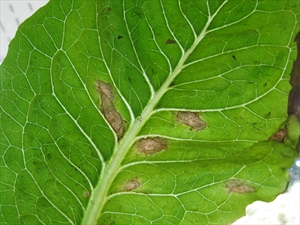Lettuce leaf spot and blight; Septoria spot, Septoria leaf spot
Pacific Pests, Pathogens, Weeds & Pesticides - Online edition
Pacific Pests, Pathogens, Weeds & Pesticides
Lettuce Septoria leaf spot & blight (150)
Septoria lactucae
Uncertain, possibly worldwide. It is recorded from Australia, Fiji, Papua New Guinea, Samoa, Solomon Islands, and Tonga.
Lettuce
Light brown irregular spots occur between the leaf veins (Photo 1); these expand rapidly and cover the leaves (Photo 2); the leaves dry out, become papery and the centres of the spots may fall out (Photo 3). Small black dots occur in the papery areas (Photo 2); these are the fruiting bodies of the fungus, and contain millions of spores.
The fungus survives in several ways: it can survive on the old leaves removed at harvest, on weeds, and also as spores on seed.
The fungus is spread when the fruiting bodies open and the spores ooze out and are spread from plant to plant in rain splash, or they are spread further in wind-driven rain.
Septoria leaf spot is a disease that can be serious during periods of high humidity or high rainfall, developing into a blight. Damage occurs in two ways: (i) many spots occur and these often merge to destroy large areas of the outer leaves and those that form the 'head' (Photo 3); (ii) the presence of leaf spots on leaves that are used for food, reduces their value.
Look for irregular brown spots, mostly on the lower leaves, which contain large numbers of small black fruiting bodies of the fungus; these are characteristic of the disease. Look to see if the spots join together and the diseased areas become papery thin. During long periods of wet weather, the young leaves of the lettuce "head" also turns brown.
CULTURAL CONTROL
Cultural control is particularly important in the management of this disease:
Before planting:
- Certified seed: Use commercially packaged seed from reputable suppliers.
- Inspect nursery plants: Check every plant in the nursery for leaf spot symptoms, and remove any seedling that shows leaf spots before transfer to the field.
During growth:
- Watering: Use a drip irrigation system rather than overhead irrigation to avoid long periods of leaf wetness, which assists the spread of spores and their infection.
- Field work: Avoid working in the fields when wet.
- Weed: Remove weeds belonging to the lettuce (daisy) family.
After harvest:
- Hygiene: Remove plant debris after harvest or incorporate it into the soil so that it decomposes quickly. Do not replant areas where there is debris from the last crop.
- Crop rotation: Do not plant crops of lettuce one after another without a break; leaves a gap of at least 3 years between consecutive crops.
RESISTANT VARIETIES
None are known.
CHEMICAL CONTROL
If chemical control is necessary, use:
- Protectant products: copper (e.g., cuprous oxide), mancozeb, chlorothalonil.
- Systemic products: triazole fungicides.
____________________
When using a pesticide (even a biopesticide), always wear protective clothing and follow the instructions on the product label, such as dosage, timing of application, and pre-harvest interval. Recommendations will vary with the crop and system of cultivation. Expert advice on the most appropriate pesticide to use should always be sought from local agricultural authorities.
AUTHOR Grahame Jackson
Information (and Photo 3) from Gerlach WWP (1988) Plant diseases of Western Samoa. Samoan German Crop Protection Project, Deutsche Gesellschaft für Technische Zusammenarbeit (GTZ) Gmbh, Germany; and Lettuce, Septoria blight (undated). The Center for Agriculture, Food, and the Environment. University of Massachusetts Amherst. (https://ag.umass.edu/vegetable/fact-sheets/lettuce-septoria-blight); and (including Photos 1&2) from Diseases of vegetable crops in Australia (2010). Editors, Denis Persley, et al.. CSIRO Publishing.
Produced with support from the Australian Centre for International Agricultural Research under project PC/2010/090: Strengthening integrated crop management research in the Pacific Islands in support of sustainable intensification of high-value crop production, implemented by the University of Queensland and the Secretariat of the Pacific Community.






